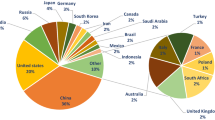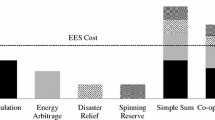Abstract
With the continuous development of the spot market, in the multi-stage power market environment with the day-ahead market and right market, the study associated with the portfolio of energy storage devices requires that attention should be paid to transmission congestion and power congestion. To maximize the profit of energy storage and avoid the imbalance of power supply and consumption and the risk of node price fluctuation caused by transmission congestion, this paper presents a portfolio strategy of energy storage devices with financial/physical contracts. First, the concepts of financial/physical transmission rights and financial/physical storage rights are proposed. Then, the portfolio models of financial contract and physical contract are established with the conditional value-at-risk to measure the risks. Finally, the portfolio models are verified through the test data of the Pennsylvania-New Jersey-Maryland (PJM) electric power spot market, and the comparison between the risk aversion of portfolios based on financial/physical contract with the portfolio of the market without rights. The simulation results show that the portfolio models proposed in this paper can effectively avoid the risk of market price fluctuations.
Similar content being viewed by others
Abbreviations
- s ∈ S :
-
Set of market price scenarios
- t ∈ T :
-
Set of simulation time slots
- i ∈ I :
-
Set of storage profits under each price scenario
- c C :
-
eongestion cost
- P T :
-
Electrical trading volume through congestion branch
- l T :
-
Locational marginal price for injection node
- l S :
-
Locational marginal price for load node
- c P :
-
power congestion cost
- P S :
-
power generation and consumption
- F :
-
Expected profit set of energy storage in some power trading days
- φ ∈ [0,1]:
-
Risk weighting parameter
- CVaR α(F):
-
CVaR of profits
- α ∈ [0.9,0.99]:
-
Confidential level
- CVaR α(X):
-
CVaR of expected profits
- \(F_t^{{(^ \ast})}\) :
-
Expected profit of the day-ahead market
- c 0 :
-
Operation cost per
- \(l_{t,(\ast)}^{(\ast)}\) :
-
Actual marginal price in period t
- \(P_t^{(\ast)}\) :
-
Purchased number in period t
- P max :
-
Maximum input/output power
- \(P_{\max}^{(\ast)}\) :
-
Maximum purchase quantity
- P dis :
-
Energy storage input power
- P cha :
-
Energy storage output power
- E t :
-
Storage capacity at time t
- E max :
-
Maximum storage capacity
- E 0 :
-
Initial storage capacity
- λ :
-
Charging and discharging efficiency of storage
- γ :
-
Normal distribution parameter
- ε :
-
Normal distribution parameter
- E 24 + 1 :
-
Storage capacity at the beginning of the next operation day
- E initial :
-
The initial state of energy storage capacity
- P t,(*) :
-
Bidding or offering in the right market at time t
- T h :
-
Time duration of the transaction of storage
- MW:
-
The capacity of energy storage
- MWh:
-
Power consumption of energy storage
- DA:
-
Day-ahead market
- RT:
-
Real-time market
- out:
-
Discharge
- in:
-
Charge
- gen:
-
Clearing price at the source node
- load:
-
Clearing price at the load node
References
Chinmoy L, Iniyan S, Goic R. Modeling wind power investments, policies and social benefits for deregulated electricity market—a review. Applied Energy, 2019, 242: 364–377
Ghorani R, Fotuhi-Firuzabad M, Moeini-Aghtaie M. Main challenges of implementing penalty mechanisms in transactive electricity markets. IEEE Transactions on Power Systems, 2019, 34(5): 3954–3956
Tudu B, Mandal K K, Chakraborty N. Optimal design and development of PV-wind-battery based nano-grid system: a field-on-laboratory demonstration. Frontiers in Energy, 2019, 13(2): 269–283
Gupta A R, Kumar A. Reactive power deployment and cost benefit analysis in DNO operated distribution electricity markets with D-STATCOM. Frontiers in Energy, 2019, 13(1): 86–98
Li P, Cai G, Zhang Y, et al. Multi-objective optimal allocation strategy for the energy internet in Huangpu District, Guangzhou, China. Frontiers in Energy, 2020, 14(2): 241–253
Vespermann N, Hamacher T, Kazempour J. Access economy for storage in energy communities. IEEE Transactions on Power Systems, 2021, 36(3): 2234–2250
Tenti P, Caldognetto T. A general approach to select location and ratings of energy storage systems in local area energy networks. IEEE Transactions on Industry Applications, 2019, 55(6): 6203–6210
Aguado J A, Quintana V H, Madrigal M, et al. Coordinated spot market for congestion management of inter-regional electricity markets. IEEE Transactions on Power Systems, 2004, 19(1): 180–187
Deng L, Li Z, Sun H, et al. Generalized locational marginal pricing in a heat-and-electricity-integrated market. IEEE Transactions on Smart Grid, 2019, 10(6): 6414–6425
Asrari A, Ansari M, Khazaei J, et al. A market framework for decentralized congestion management in smart distribution grids considering collaboration among electric vehicle aggregators. IEEE Transactions on Smart Grid, 2020, 11(2): 1147–1158
Huang S, Wu Q, Shahidehpour M, et al. Dynamic power tariff for congestion management in distribution networks. IEEE Transactions on Smart Grid, 2019, 10(2): 2148–2157
Han D, Zhang C, Ping J, et al. Smart contract architecture for decentralized energy trading and management based on block-chains. Energy, 2020, 199: 117417
Weibelzahl M. Nodal, zonal, or uniform electricity pricing: how to deal with network congestion. Frontiers in Energy, 2017, 11(2): 210–232
Mahesh A, Sandhu K S. A genetic algorithm based improved optimal sizing strategy for solar-wind-battery hybrid system using energy filter algorithm. Frontiers in Energy, 2020, 14(1): 139–151
Sharma R, Suhag S. Feedback linearization based control for weak grid connected PV system under normal and abnormal conditions. Frontiers in Energy, 2020, 14(2): 400–409
Hartwig K, Kockar I. Impact of strategic behavior and ownership of energy storage on provision of flexibility. IEEE Transactions on Sustainable Energy, 2016, 7(2): 744–754
Paterakis N G, de la Nieta A A S, Bakirtzis A G, et al. Effect of risk aversion on reserve procurement with flexible demand side resources from the ISO point of view. IEEE Transactions on Sustainable Energy, 2017, 8(3): 1040–1050
Saber H, Heidarabadi H, Moeini-Aghtaie M, et al. Expansion planning studies of independent-locally operated battery energy storage systems (BESSs): a CVaR-based study. IEEE Transactions on Sustainable Energy, 2020, 11(4): 2109–2118
Liu X, Yan Z, Wu J. Optimal coordinated operation of a multi-energy community considering interactions between energy storage and conversion devices. Applied Energy, 2019, 248: 256–273
Naderi M, Hashemi F, Bekker A, et al. Modeling right-skewed financial data streams: a likelihood inference based on the generalized Birnbaum-Saunders mixture model. Applied Mathematics and Computation, 2020, 376: 125109
Lo Prete C, Guo N, Shanbhag U V. Virtual bidding and financial transmission rights: an equilibrium model for cross-product manipulation in electricity markets. IEEE Transactions on Power Systems, 2019, 34(2): 953–967
Taylor J A. Financial storage rights. IEEE Transactions on Power Systems, 2015, 30(2): 997–1005
Gribik P R, Shirmohammadi D, Graves J S, et al. Transmission rights and transmission expansions. IEEE Transactions on Power Systems, 2005, 20(4): 1728–1737
Baldick R. Border flow rights and contracts for differences of differences: models for electric transmission property rights. IEEE Transactions on Power Systems, 2007, 22(4): 1495–1506
Thomas D, Kazempour J, Papakonstantinou A, et al. A local market mechanism for physical storage rights. IEEE Transactions on Power Systems, 2020, 35(4): 3087–3099
Budworth L, Prestwich A, Sykes-Muskett B, et al. A feasibility study to assess the individual and combined effects of financial incentives and monetary contingency contracts on physical activity. Psychology of Sport and Exercise, 2019, 44: 42–50
Leshno J D, Pradelski B S R. The importance of memory for price discovery in decentralized markets. Games and Economic Behavior, 2021, 125: 62–78
Madrigal M, Flores M. Integrated software platform to teach different electricity spot market architectures. IEEE Transactions on Power Systems, 2004, 19(1): 88–95
Gui Z, von Thadden E L, Zhao X. Incentive-compatibility, limited liability and costly liquidation in financial contracting. Games and Economic Behavior, 2019, 118: 412–433
Hogan W W. Contract networks for electric power transmission. Journal of Regulatory Economics, 1992, 4(3): 211–242
Muñoz-Álvarez D, Bitar E. Financial storage rights: definition and basic properties. In: 2014 North American Power Symposium (NAPS), Pullman, WA, USA, 2014: 1–6
Quintela F R, Redondo R C, Melchor N R, et al. A general approach to Kirchhoff’s laws. IEEE Transactions on Education, 2009, 52(2): 273–278
Sioshansi R. Using storage-capacity rights to overcome the cost-recovery hurdle for energy storage. IEEE Transactions on Power Systems, 2017, 32(3): 2028–2040
Cui S, Wang Y, Li C, et al. Prosumer community: a risk aversion energy sharing model. IEEE Transactions on Sustainable Energy, 2020, 11(2): 828–838
Palomba G, Riccetti L. Portfolio frontiers with restrictions to tracking error volatility and value at risk. Journal of Banking & Finance, 2012, 36(9): 2604–2615
Catalao J P S, Pousinho H M I, Mendes V M F. Optimal offering strategies for wind power producers considering uncertainty and risk. IEEE Systems Journal, 2012, 6(2): 270–277
Author information
Authors and Affiliations
Corresponding author
Rights and permissions
About this article
Cite this article
Lan, P., Han, D., Zhang, R. et al. Optimal portfolio design of energy storage devices with financial and physical right market. Front. Energy 16, 95–104 (2022). https://doi.org/10.1007/s11708-021-0788-2
Received:
Accepted:
Published:
Issue Date:
DOI: https://doi.org/10.1007/s11708-021-0788-2




